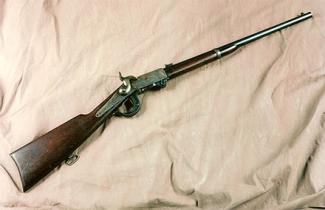Fourth Model with back action lock, Designed to fire a tapered cartridge
Serial No. 19184. Calibre.55 .c1864.
Ambrose Everett Burnside was born in 1824 and graduated from the U.S Military Academy in 1847. He was posted as a Lieutenant of Artillery to Mexico and went on to serve with the Artillery in the new territories in the South Western US where he was wounded in a skirmish with the Apache Indians in 1849. His last Military posting was at Fort Adams, in Newport, Rhode Island.
During this period Burnside requested permission to have the Springfield Armoury make up a model of a firearm of his design. This was probably for the purpose of satisfying the ‘working model’ requirement of the U.S. Patent Office. Using this design Burnside established his fist company, Burnside and Bishop, in 1853. A fire destroyed the premises in late 1853 and he used the insurance settlement to establish the Bristol Firearm Co in 1854. Burnside was fortunate in being able to employ Massachusetts gunsmith George P Foster to assist him in the early stages of his company’s development. Bristol Firearms produced locks and other parts for the firearms trade and this was to keep the Company solvent while Burnside perfected his carbine design. He received his first Patent for the original Carbine on March 25th, 1856. Foster’s greatest contribution to the design was probably the form of twist rifling (gain twist, the rate of twist increases towards the muzzle) that came to be utilised in all Burnsides carbines, giving a great improvement in accuracy. At this time there was only one other breech loading weapon in service, the Hall carbine. This had originally been adopted in flintlock form by the U.S. Army in 1817, with a later version being patented in 1844.
The Hall suffered from gas leakage and fouling and was prone to having cases stick in the breech block. Burnside was able to address all these problems with the new carbine. The most notable feature of the Burnside is its use of a tapered cartridge. The use of this, combined with a plunger in the back of the breech block, eliminated the problem of stuck cases. This plunger also keeps the cartridge firmly in place between the mouth of the barrel and the breech block. Closing the action of the weapon pinches the cartridge very tightly between barrel cone and block, forming a very tight gas seal. The instructions for loading Burnside cartridges, printed in 1861 require the use of tallow or beeswax which helps to reduce fouling in the barrel. Later cartridges have a pronounced ring just below the bullet, which was patented in 1860 to contain the wax and provide an even more effective gas seal. The cartridge is fired by a percussion cap struck by the hammer in the normal way. There is a small hole at the base of the case that allows the flash to fire the main charge.
There are five models of the Burnside Carbine, each of which incorporates minor improvements. The Vokes Collection example is a Fourth Model, sometimes referred to as the ‘New Model’ that includes many of the improvements that Foster developed. Delivery of this model began in late 1861.
The Bristol Firearms Co. was reorganised to form The Burnside Rifle Company in May 1861, a new factory being completed in 1862. Unfortunately, Burnside had a reputation for late delivery and by the end of 1862 was far behind in his contracts.



